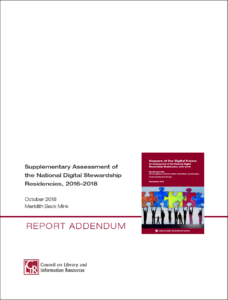Contact: Kathlin Smith
202-939-4754
Washington, DC, October 25, 2018—CLIR today released an assessment of three recent National Digital Stewardship Residency (NDSR) initiatives focusing on public media, art, and biodiversity.
NDSR programs, first established in 2013, place graduates of master’s programs in information science and related fields at cultural heritage organizations to pursue projects related to the collection, selection, management, preservation, and accessibility of digital material. The report, which builds on an assessment of earlier cohorts published in 2016, focuses on three programs:
- AAPB NDSR, funded by an IMLS grant to WGBH on behalf of the American Archive of Public Broadcasting, a collaboration between the WGBH Education Foundation and the Library of Congress
- NDSR Art, funded through an IMLS grant to the Philadelphia Museum of Art in partnership with the Art Libraries Society of North America (ARLIS/NA)
- NDSR Foundations to Actions, funded by an IMLS grant to Harvard University on behalf of the Biodiversity Heritage Library (BHL).
 The three programs are distinctive in that they placed residents in host organizations across the country, marking a departure from the regionally based programs in New York, Boston, and Washington, DC, which were the subject of CLIR’s earlier study.
The three programs are distinctive in that they placed residents in host organizations across the country, marking a departure from the regionally based programs in New York, Boston, and Washington, DC, which were the subject of CLIR’s earlier study.
Report author Meridith Mink highlights the successes and challenges of the distributed cohorts, based on feedback from the assessment participants. “Most participants in the distributed cohorts were satisfied with their NDSR experience and echoed much of the feedback provided by earlier regional cohort members about the successes and challenges of the programs,” she notes. “Physical distance between residents and between host organizations apparently did not introduce significant new challenges.” In fact, because virtual work environments are increasingly common, providing NDSR residents with virtual work experience was seen as a clear advantage of the distributed model. Program leaders made sure to incorporate opportunities for face-to-face interaction among their residents through an initial immersion week, conference attendance, and a capstone event.
Since CLIR’s original assessment, NDSR community members have made progress toward developing a national governance and support structure for NDSR. Best practices and guidelines for the operation of an NDSR program have been published, as have documents relating to sustainability strategies and a coordinated national model. But challenges remain, including branding and raising awareness of the NDSR program. Specific recommendations include bolstering the current website to highlight more visibly the outcomes of individual NDSR projects, creating an alumni directory, and engaging alumni as mentors and advisors to new residents.
Supplementary Assessment of the National Digital Stewardship Residencies, 2016–2018, by Meridith Beck Mink, is available at https://www.clir.org/pubs/reports/pub173/
CLIR is an independent, nonprofit organization that forges strategies to enhance research, teaching, and learning environments in collaboration with libraries, cultural institutions, and communities of higher learning. It aims to promote forward-looking collaborative solutions that transcend disciplinary, institutional, professional, and geographic boundaries in support of the public good.

